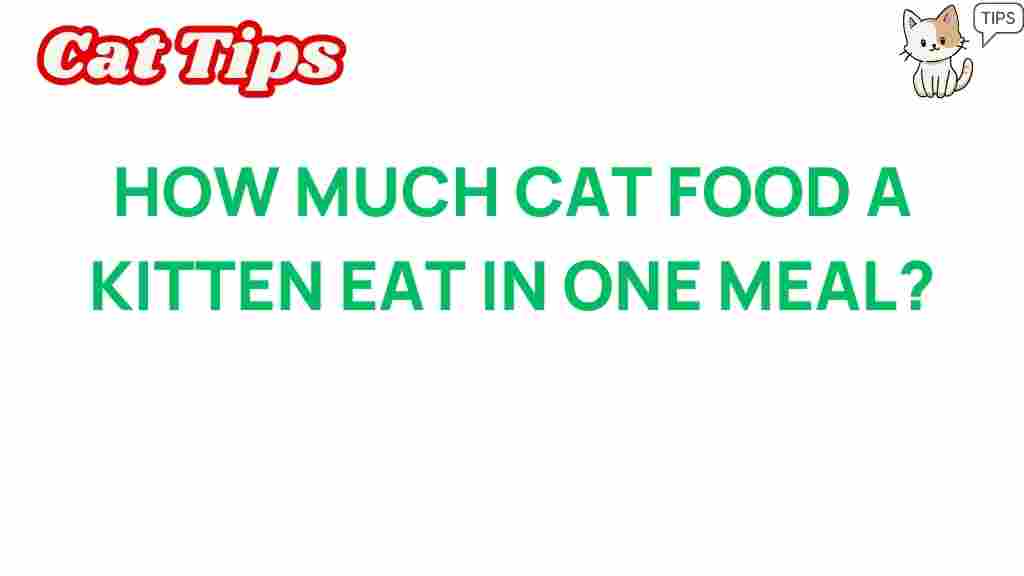Unraveling the Mystery: How Much Cat Food Should Your Kitten Eat?
As a new kitten owner, you might find yourself overwhelmed with the number of choices available for your little furry friend. One of the most pressing questions is: how much cat food should your kitten eat? Understanding the right kitten diet is essential for your pet’s growth and development. In this article, we will guide you through the intricacies of a kitten’s dietary needs, ensuring you can provide the best care possible.
Understanding Your Kitten’s Nutritional Needs
Kittens grow rapidly during their first year of life, and their nutritional requirements differ significantly from adult cats. Here’s what you need to know about a proper kitten diet:
- Caloric Intake: Kittens require more calories per pound of body weight than adult cats. A general guideline is about 30-50 calories per pound of body weight.
- Protein Content: High-quality protein is crucial for muscle development. Look for foods with at least 30% protein.
- Fat Content: Healthy fats are important for energy and skin health. A kitten’s diet should contain around 15-20% fat.
- Vitamins and Minerals: Essential nutrients support overall health and development, including calcium and phosphorus for bone growth.
Choosing the Right Cat Food
When selecting food for your kitten, you will come across various options: dry kibble, wet food, and raw diets. Each has its advantages:
- Dry Food: Convenient and cost-effective, dry food can help keep teeth clean but may lack moisture.
- Wet Food: Higher in moisture, wet food is great for hydration and is often more palatable for kittens.
- Raw Diet: While some owners prefer feeding raw, it requires careful handling and preparation to avoid health risks.
Always choose food labeled specifically for kittens, as it meets their unique nutritional requirements. Consult your veterinarian for recommendations based on your kitten’s specific needs.
How Much Should Your Kitten Eat?
Determining the right portion size for your kitten can be a bit tricky. Here’s a step-by-step guide to help you:
- Weigh Your Kitten: Regularly monitor your kitten’s weight using a kitchen scale. This will help you gauge their growth and adjust their food intake accordingly.
- Check the Feeding Guidelines: Most cat food packaging includes feeding guidelines based on your kitten’s weight. Use this as a baseline.
- Divide Meals: Kittens should be fed multiple small meals throughout the day. Aim for 3-4 meals for very young kittens and 2-3 meals for older ones.
- Observe Your Kitten: Pay attention to your kitten’s body condition. If they are gaining weight too quickly or too slowly, adjust the portion sizes accordingly.
Sample Feeding Schedule
Here’s a sample feeding schedule based on the age of your kitten:
- Under 4 months: 4 meals a day, a total of 200-300 calories.
- 4-6 months: 3 meals a day, a total of 250-350 calories.
- 6-12 months: 2 meals a day, a total of 300-400 calories.
Signs of a Healthy Diet
To ensure your kitten is thriving on their kitten diet, watch for these signs:
- Healthy weight gain: Kittens should gradually gain weight, with an average of 1-2 pounds per month.
- Shiny coat: A well-nourished kitten will have a soft, shiny coat.
- Active behavior: Kittens should be playful and energetic.
- Good digestion: Healthy stools and regular bathroom habits are indicators of a balanced diet.
Troubleshooting Common Feeding Issues
Even with the best intentions, you may encounter some challenges when feeding your kitten. Here are some common issues and how to address them:
1. Picky Eaters
If your kitten refuses to eat, consider the following:
- Try different flavors or brands of food.
- Mix wet and dry food to enhance flavor and texture.
- Warm up wet food slightly to enhance its aroma.
2. Overeating or Underfeeding
It’s important to strike a balance:
- If your kitten is always begging for food, check their weight and adjust portions.
- If your kitten seems uninterested in food, consult your vet to rule out health issues.
3. Digestive Issues
Watch for signs of digestive discomfort:
- Loose stools or diarrhea could indicate a food intolerance or too many treats.
- Vomiting may be a sign of overfeeding or eating too quickly. Consider using a slow feeder bowl.
Conclusion
Feeding your kitten the right amount of food is critical to their growth and overall health. By understanding their unique nutritional needs and adjusting their kitten diet as they grow, you can ensure that they thrive. Always consult your veterinarian if you have concerns about your kitten’s eating habits or health.
For more information on cat care, visit this resource. If you’re looking for a high-quality kitten food recommendation, check out this guide.
With the right approach, you can provide your kitten with a balanced diet that sets the foundation for a healthy, happy life!
This article is in the category Nutrition and created by CatTips Team
